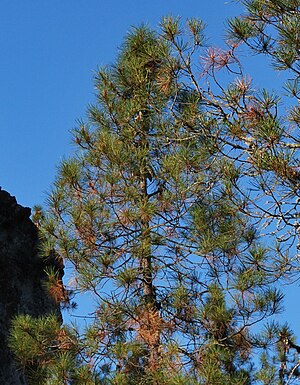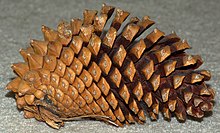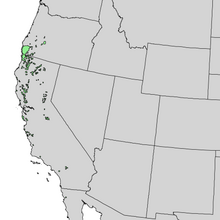Pinus attenuata
| Pinus attenuata | ||||||||||||
|---|---|---|---|---|---|---|---|---|---|---|---|---|

Pinus attenuata |
||||||||||||
| Systematics | ||||||||||||
|
||||||||||||
| Scientific name | ||||||||||||
| Pinus attenuata | ||||||||||||
| Lemmon |
Pinus attenuata is a plant from the genus of pine trees ( Pinus ) within the family of the Pinaceae (Pinaceae). The natural range is in the southwestern United States in Oregon and California and extends slightly beyond the border to Mexico. It is hardly used economically or for horticulture and is not endangered.
description
Appearance
Pinus attenuata grows as an evergreen tree that usually reaches heights of 15 to 20 meters, rarely up to 25 meters. This species can also grow shrub-like on particularly nutrient-poor soils. The trunk is straight or sometimes curved and reaches a diameter of 40 to 50 centimeters at chest height . The trunk bark is gray-brown to gray, thin, scaly and breaks into small, rectangular plates. The branches are horizontal or erect and form an irregular or rounded, open crown. The shoots are thin and red-brown. They often have multiple knots and are covered with short, sagging and permanent pulvini .
Buds and needles
The buds are ovate to ovoid-cylindrical and resinous. Terminal buds are 15 to 30 millimeters long and 10 to 15 millimeters thick, lateral buds are shorter. The bud scales are brown, sub-like , dry-skinned, with an irregularly serrated, translucent edge and a pointed end. The needles grow in threes, less often in pairs, in a needle sheath that is initially 10 to 18 millimeters long and later shortens to 3 to 6 millimeters and remains on the tree for two to three years. They are light green and sometimes with a slightly bluish tinge, inelastic, straight or hanging, rarely from 8, usually 10 to 12 and sometimes up to 14 centimeters long and 1 to 1.5 millimeters wide. The edge of the needle is finely sawn, the end pointed. There are gap lines on all sides of the needle, eight to twelve on the convex, abaxial side and three to five on the two adaxial sides.
Cones and seeds
The pollen pins are ovate to oblong to cylindrical and yellowish brown to yellow at a length of 15 to 20 mm and a diameter of 5 to 7 millimeters. The seed cones grow individually, in pairs, or in whorls of three to five near the ends of the branches on short, strong, curved stems. Fully grown cones appear seated, they are bent back, ovate, elongated to ovate-narrowed, asymmetrically shaped, 8 to 15 centimeters long, closed with a diameter of 3.5 to 6 centimeters and open with a diameter of up to 8 centimeters. The seed scales are thick, elongated, straight or slightly curved and purple to reddish brown. The apophysis has a rhombic or pentagonal outline, it is ocher to yellowish brown, slightly shiny and weathered gray. On the underside of the peg it is only slightly raised on the top conical and curved, towards the base of the peg it reaches a length of 10 millimeters. The umbo is darker than the apophysis, rhombic, almost flat to pyramidal or hook-shaped, unreinforced and reaches a size of 5 millimeters. The seed cones ripen after two years, but can remain closed for another 20 years or more or only open when exposed to fire.
The black-gray seeds are 5 to 7 millimeters in length and 2.3 to 4.5 millimeters in diameter obliquely egg-shaped and flattened. The seed wing is yellowish to gray-brown, elongated, curved on one side, 12 to 18 millimeters long and 5 to 7 millimeters wide.
Chromosome number
The number of chromosomes is like all pine 2n = 24th
Occurrence and endangerment
The natural range of Pinus attenuata is in the United States in southwest Oregon and in California and in the northwest of the Mexican state of Baja California . Pinus attenuata grows in chaparral and similar types of vegetation, but also on very rocky ground. It has extremely persistent cones and is one of the first trees to repopulate the devastated area after a fire. In the northern part of the distribution area, in which the trees are also a bit taller, it grows together with various oak species ( Quercus spec.). In the United States, it grows at altitudes of 300 to 1200 meters and rarely reaches 1700 meters. In Mexico they are usually found at altitudes of 250 to 600 meters or near the sea coast. The distribution area is assigned to winter hardiness zone 7 with mean annual minimum temperatures of −17.7 ° and −12.2 ° Celsius (0 to 10 ° Fahrenheit ).
In the Red List of the IUCN is Pinus attenuata "not at risk" (= "Lower Risk / least concern") classified. However, it should be noted that a reassessment is necessary.
Systematics
The first description of Pinus attenuata was in 1892 by John Gill Lemmon in Garden and Forest; a Journal of Horticulture, Landscape Art and Forestry , Volume 64, page 45. The specific epithet attenuata is a Latin word that means "weakened" or "narrowed" and refers to the pointed shape of the cones. Synonyms for Pinus attenuata are: Pinus californica Hook. & Arn. , Pinus californica Hartw. , Pinus tuberculata Gordon , Pinus tuberculata D. Don , Pinus tuberculata var. Acuta Mayr .
The species Pinus attenuata belongs to the Australes subsection from the Trifoliae section in the Pinus sub-genus within the Pinus genus .
Pinus attenuata does not form a natural hybrid. Crossing attempts with Pinus radiata and Pinus muricata were successful. These three types are sometimes grouped together as a group called California closed-cone pines .

use
The wood of Pinus attenuata is hardly used economically. Due to the small size and irregular shape, the quality of the wood is low. Growth in the arid conditions is slow, except when repopulating fire-destroyed forests. However, polished trunk cross-sections with ingrown cones are sometimes offered for sale as a curiosity. The species is hardly used in horticulture and its cultivation is limited to arboretums in areas with a Mediterranean or similar climate.
swell
literature
- Aljos Farjon: A Handbook of the World's Conifers . tape 2 . Brill, Leiden-Boston 2010, ISBN 90-04-17718-3 , pp. 634-635 .
- Robert Kral: Pinus. : Flora of North America Editorial Committee (Ed.): Flora of North America North of Mexico . Volume 2: Pteridophytes and Gymnosperms . Oxford University Press, New York / Oxford a. a. 1993, ISBN 0-19-508242-7 (English).
Individual evidence
- ↑ a b c Christopher J. Earle: Pinus attenuata. In: The Gymnosperm Database. www.conifers.org, November 27, 2012, accessed April 21, 2013 (English).
- ↑ a b c d e f g Aljos Farjon: A Handbook of the World's Conifers , Volume 2, p. 635.
- ↑ a b c Robert Kral: Pinus. : Pinus attenuata Lemmon - same text online as the printed work , In: Flora of North America Editorial Committee (Ed.): Flora of North America North of Mexico. Volume 2: Pteridophytes and Gymnosperms. Oxford University Press, New York and Oxford, 1993, ISBN 0-19-508242-7 .
- ↑ a b Pinus attenuata in the Germplasm Resources Information Network (GRIN), USDA , ARS , National Genetic Resources Program. National Germplasm Resources Laboratory, Beltsville, Maryland. Retrieved April 21, 2013.
- ↑ Pinus attenuata in the endangered Red List species the IUCN 2012. Posted by: Conifer Specialist Group, 1998. Accessed April 7, 2013.
- ↑ a b Pinus attenuata at Tropicos.org. Missouri Botanical Garden, St. Louis, Retrieved April 20, 2019.
- ↑ Helmut Genaust: Etymological dictionary of botanical plant names. 3rd, completely revised and expanded edition. Nikol, Hamburg 2005, ISBN 3-937872-16-7 , p. 86 (reprint from 1996).
- ^ Aljos Farjon: A Handbook of the World's Conifers , Volume 2, p. 634.
Web links
- Vascular Plants of the Americas : Pinus attenuata at Tropicos.org. In: 83 . Missouri Botanical Garden, St. Louis




